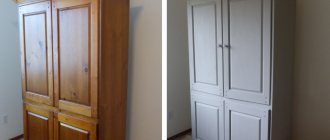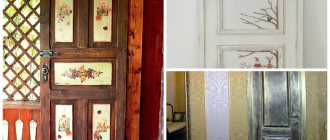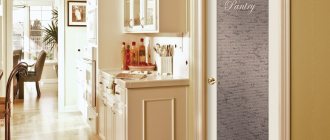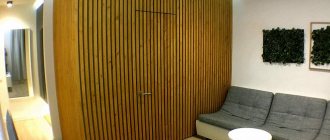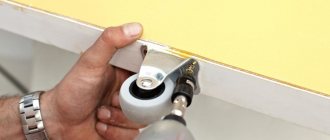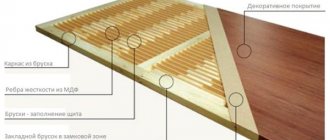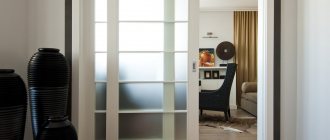The decorative covering of a door deteriorates over time and loses its attractiveness. If the old paint is cracked and peeling in places, it is recommended to remove the old coating before applying a new coat. But it also happens that the surface has only lost its shine, has become dull, or spots have appeared on it, but the layer itself lies smoothly and has retained its integrity. In such cases, there is no point in carrying out work to remove the old coating. It will not be possible to qualitatively remove the old layer of paint that has retained its strength. It is difficult to remove. As a result, you can only damage the doors or get a surface whose quality is much lower than the original version.
Features of painting over an old layer
At first glance, painting a wooden door over an old layer seems like a trivial matter: just go ahead and paint it.
Painting the door
But in fact, in order to paint a wooden door and get a surface that will be no worse in quality than factory painting, learn a few rules:
- The surface of the door, regardless of its condition, must be carefully prepared. Against the background of the old paint, cracks and potholes are invisible, but after applying a new layer they will appear and ruin all your efforts.
- The right choice of material for painting an interior door. It’s not just a matter of proper selection of color, surface texture or the strength of the film formed. It is important to consider the compatibility of materials. Many paints are not compatible with each other, and if chosen incorrectly, the old coating may curl or bulge when it comes into contact with the new material.
- Decide on the correct paint application technique. For doors with a complex structure, it is possible to obtain a smooth and neat surface with proper selection and combination of painting techniques and painting tools.
The last rule, common to all cases of working with paint, is to strictly follow the instructions for applying the selected paint material.
How to paint wood
In the modern building materials market there is a large selection of coloring compositions. The choice in favor of one or another substance is determined by your desire to preserve the natural beauty of the tree or make its appearance more original and unusual. There are several types of dyes:
- opaque enamel;
- acrylic, polyurethane, perchlorovinyl and oil paints;
- varnishes, tinted or transparent;
- stains and oil impregnations.
The latter are perfect for creating an original interior. They can refresh the color of a wood surface or give it a number of new shades. Experts in the field of construction and cladding recommend that beginning craftsmen give preference to water-based acrylic paints. Such substances are very convenient to work with a brush; they have excellent consistency and excellent spreadability. The ability to evenly cover the surface being treated is somewhat worse than that of oil paints.
Also, alkyd paints and varnishes are suitable for painting wooden doors. These substances have water-repellent properties, are resistant to frequent temperature changes and dry fairly quickly. Alkyd paints can be used to paint both interior and exterior doors. They are also used to paint bath doors, thanks to the qualities described above.
If you choose these particular substances, you must take into account that they only paint completely dry surfaces. Otherwise, the layers of paint will very quickly become covered with cracks and many bubbles will form underneath them. In this case, the aesthetic appearance of the door will deteriorate significantly.
Which paint to choose
First, decide what paints are used to apply to the door:
- Alkyd enamels. This is the most affordable option. Film strength is average. The advantages include a large range of colors and compatibility with MDF, fiberboard and wood. The main disadvantage is the long drying time and the characteristic pungent odor. Among materials of this type there are a large number of glossy coatings.
- Acrylic enamels. This type of paint is a water dispersion of acrylates. The main advantage over other compositions is the absence of odor and quick drying. In addition, the color palette, represented by hundreds of colors, allows you to create unique shades yourself. To protect the surface, it is additionally coated with parquet transparent varnish.
- Oil-based tinting paints are great for transforming interior and entrance doors. Absorbing into the wood texture they give it a unique shade. The only condition for their use is wood, without any coating.
Variety of paints and varnishes
- Nitro enamels. They dry quickly, but at the same time the volatile, caustic solvent evaporates, which can cause poor health and even poisoning. If you take precautions and use personal protective equipment when working, then this option deserves attention. After the solvent has completely evaporated, the coating becomes safe. It is considered a high-quality and fast method of painting.
- Colored varnishes, glazes. These materials are used for painting varnished door panels. Used in cases where there are no significant cracks or chips on the base. To fully restore the varnished surface, the old varnish must be removed, or you can refuse to re-varnish and paint over the interior doors after puttying.
How to properly paint doors to look like natural wood (video)
If you want to decorate the interior of your home with stylish interior doors made of natural wood, but you think that buying such a door is not a cheap pleasure, you can get by with simply painting the door to look like wood.
Painting a door to match the color of wood
Today, the technique of painting door panels to look like natural wood of any type is considered one of the most common and popular. This technology allows you to create an attractive effect at home on an old door leaf, which will practically not differ in appearance from real wood.
This technology is quite simple, despite the end result. It involves the use of a special varnish base for application to doors. Using a special method of applying varnish, you can achieve maximum resemblance to natural wood of various species.
A painted door is almost indistinguishable from a new one
This technology also allows you to achieve a luxurious “antiquity” effect and get a beautiful door leaf with an antique effect at home, using a minimum of materials and tools. To create a similar style for your entrance or interior door, you need to prepare the door leaf before starting work.
The old interior door should be removed from its hinges and all elements of door hardware should be dismantled. The surface of the door leaf must be cleaned of dirt, dust and a layer of old paint, if any. First you need to remove the cracked layer of paint, and then clean the surface with sandpaper and sand it thoroughly.
Removing the old door
In addition, this technology of turning an old interior door into a work of art can also hide some defects in the door frame. If the old door has small cracks and other unpleasant defects, they can be thoroughly sanded using regular putty. Believe me, traces of putty application will not be visible under a layer of varnish and special paint of a rich wood shade.
Sanding the door
The technology of painting a door to look like natural wood begins with preparing the door leaf, removing it, cleaning it and sealing cracks. Next, using stain, the door leaf is covered with several layers. This will allow you to achieve different woody effects. Before painting the door leaf itself, you can practice on a small piece of wood.
Training on a small piece of wood
On a surface painted with stain, various effects of antiquity, wear and scratches are created. They are created using brushing, as well as through the use of special paint of different shades. After the procedure, the door leaf should be covered with one or two layers of colorless varnish.
Antique doors
It is worth considering that when covering a door with stain or creating aging effects, various hairs may form on the surface, which must be removed by sanding. The last stage of creating an original door to look like natural wood is drying, installing handles and other fittings.
Material Compatibility
It is not so easy to understand the modern variety of materials. Chemical compositions for the uninitiated person are a secret behind seven locks, and when buying a material to apply to old paint, many rely on luck, hoping that the old layer will not react in any way to contact with the new chemical. There are some recommendations according to which you should select the material depending on what the door is painted with.
Variety of colors
Therefore, before you go for paint, you need to clarify what the canvas is painted with.
- Epoxy and polyurethane compounds contain aggressive solvents. Cyclohexanone or xylene are capable of destroying materials that are reversible polymers obtained by natural curing (nitrocellulose, vinyl, copolymer-vinyl chloride compounds). Simply put, epoxy or polyurethane paint will destroy the coating made with nitro paints.
- Epoxy and polyurethane materials are applied only over the same compositions or primers, maintaining drying intervals for each layer.
- Silicate compounds are generally not applied over any other types of paints.
- Alkyd paints are not aggressive and can be safely applied over any material.
- Copolymer-vinyl chloride compounds and compounds based on chlorine rubber are applied only over acrylic, epoxy, and silicate materials.
Important! To update the door, it is better to use paint of the same type as the previous layer.
Compatibility table
Despite the recommendations of the material compatibility table, it is better to use an experimental test: apply the new material to a small area of the canvas and see the reaction.
Features of working with different surfaces
If the old door looks good, but the coating has only faded and worn out, then it can be quickly updated by such an event as painting the door without removing the previous layer. The tactics of work will depend on the type of coating available:
Painted doors
This option will cause the least amount of trouble with preparation and has every chance of getting a high-quality surface. To paint interior doors with your own hands, just thoroughly wash the surface of the door to remove dirt and grease stains, and fill all cracks and gaps with putty. It is better to take automotive epoxy paints with a hardener. Such putties do not shrink when dry, and all defects can be repaired in one go.
After the putty has dried, the surface is sanded with fine (120 grit) sandpaper. It is better to use a vibrating sander on large flat surfaces (counters, panels). The main task when working with a painted door is high-quality painting, which is achieved by applying several uniform layers of material. The duration of the work will directly depend on the time it takes for the next painted layer of the door to completely dry.
Old painted door
Lacquered doors
If you decide to renew the varnish surface by applying a new layer, it should be taken into account that all defects will remain visible.
Important! Secondary varnishing rarely gives the expected results. As a rule, the surface should be close to ideal. If you don’t want to tinker with the old coating, then it’s better to paint varnished interior doors that have lost their appearance or coat them with a tinted glaze.
The main difficulty in this situation is selecting putty to match the base material. But the wooden surface is not monochromatic in nature. Even if you spend a lot of time and use several shades of putty, you will still end up with stains on the canvas.
Preparing the door surface
This process has several stages.
At the first stage, the old facing material is removed. This includes layers of paint, primer and putty. All this must be completely removed down to the wooden surface. Here it is ideal to use a high-quality hair dryer and then remove the material with a spatula. An alternative to such equipment is sandpaper or a grinder. In addition, you can use special wood removers.
Next, the surface of the wooden door must be carefully sanded and all kinds of defects on it must be eliminated. This includes cracks, scratches, dents and the like. At this stage, craftsmen often use sandpaper or a sander attached to a vacuum cleaner. This process must be performed with special care. Before proceeding with the next work, the surface of the door is carefully inspected to ensure quality.
Large imperfections are easier to completely cover up. If you plan to cover the door with varnish, oil or stain, the putty should be specialized for wood. In the case when opaque enamel is used, the color of the putty does not matter.
The packaging with putty indicates its drying time. It must be maintained, and only then the grinding process can be started a second time. Regular sandpaper is quite suitable for this. Deep dents can be easily repaired with putty that does not contain fiberglass.
Door painting technologies
The quality of the door coating depends on the tool, application method and professional skills of the craftsman.
Tools
Door painting is done using the following tools:
- Brushes. It is not recommended to paint the entire canvas with just one brush. If you lack experience, the surface will end up with streaks. It will not be possible to apply a thin, even layer of paint with a brush. But without this tool it will not be possible to paint hard-to-reach places, corners, layout patterns or panel margins. Therefore, when painting canvases with a complex configuration, first work with a brush, painting over problem areas.
- Roller. Repainting panel interior doors is done with just a roller. The roller bobbin must be fur, polyamide or polyacrylic. These materials are resistant to most aggressive solvents.
Important! For painting work on door restoration, foam rollers are not used.
Working with a brush
- Compressor (spray gun). A spray bottle will allow you to get an even, thin layer. The result is a perfectly smooth coating. The process of applying paint is much faster than manually.
Related tools you can’t do without:
- gloves;
- paint tray;
- rags;
- masking tape;
- sandpaper;
- putty knife;
- and what you have at your disposal: stools on which you will place the canvas, or sawhorses.
In addition to paint and varnish, prepare putty, primer and solvent.
How to choose the right paint?
Requirements for the coloring composition:
- hiding power - the ability of a material, when applied to a surface, to evenly cover the original shade;
- drying speed is an important criterion, since we are talking about painting indoor doors: prolonged inhalation of the pungent odor that most compositions have can negatively affect the well-being of those living in the house;
- resistance to abrasion and moisture - the higher these indicators, the longer the new coating will last.
The most popular compositions:
- Alkyd enamels: characterized by low price, wide range of colors, durability and wear resistance. A significant drawback of the material is its pungent odor, which persists for several days after painting, so it is undesirable to use the composition in rooms where people prone to allergic reactions, asthmatics and children live.
- Acrylic paints: easy to use, have high covering ability, do not emit a toxic odor, and dry quickly. Disadvantage - due to the insufficient abrasion resistance of the material, the canvas treated with an acrylic composition must be additionally varnished.
- Nitro enamels: create a uniform, smooth layer on the surface that is resistant to mechanical stress. The paint has a toxic, pungent odor.
- Oil formulations: inexpensive, have a long service life. The downside of the product is that it takes a long time to dry.
- Polyurethane paints: characterized by high adhesion to different surfaces, moisture resistance, resistance to mechanical stress, and elasticity. Their disadvantage is their high price.
Attention
The choice of paint also depends on the material from which the canvas is made.
Any composition is suitable for a wooden door; materials such as wood fiber (MDF) and chipboards are treated with products containing tone and varnish. Veneered sashes cannot be painted with nitro enamels; polyurethane products are used to restore their appearance.
Painting schemes
First, a little theory. The interior door can be panel or panel. Depending on this, the execution scheme and the order of staining will depend.
If it is a panel-type canvas, then painting is carried out in 3 stages:
- Coloring begins from the upper corner in the transverse direction. The movement of the brush goes from left to right.
- the second layer of paint is applied in the longitudinal direction.
- the third layer is similar to the first.
Please note that three layers cannot be applied at once; after each coating, time must pass for the composition to dry.
For work, it is better to use a roller, as the brush may leave streaks.
If it is a paneled door, then first all the recesses are painted with a brush, and then the rest of the panel, but with a roller.
Stages of work
All work can be written in the form of the following algorithm:
- It is better to remove the door and twist the fittings. If there is no such possibility (or desire), then handles, hinges, locks and glass are sealed with film and masking tape. It will be difficult to remove the paint. The tape must be removed before the paint dries.
- Washing and drying the door surface.
- Removing peeling areas, filling defects, sanding. Each layer is sanded after complete drying.
- Selecting the type of paint material.
- Applying a primer (paint diluted with the same type of solvent). This will improve adhesion and reduce the likelihood of bleed through putty areas.
- Applying the required number of layers of paint or varnish.
